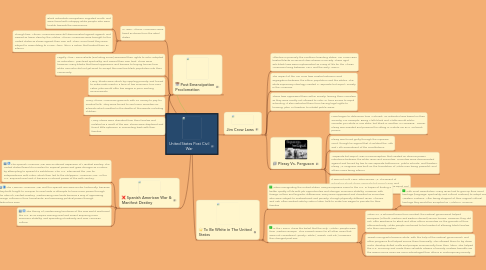
1. Post Emancipation Proclomation
1.1. In 1863- African Americans were freed as slaves from the rebel states.
1.1.1. Black individuals everywhere migrated North, and were faced with unhappy white people who were hostile towards the newcomers.
1.1.2. Though free, African Americans were still discriminated against against, and viewed as lower class by the Whites. African Americans were brought to the United States as slaves against their own will. Then, once freed they were subject to assimilating to a new "free" life in a nation that treated them as inferior.
1.2. Legally "free" some Blacks (excluding some) exercised their rights to vote, adopted an education, practiced spirituality, and owned their own land. There were however, many blacks that faced oppression and barriers to buying homes from white men who did not yet want to accept the new free black population into their community.
1.3. Many blacks were struck by crippling poverty, and forced to make ends meet in a time of low economic turn over. Labor jobs would offer low wages in poor working environments.
1.4. Many African Americans grew sick with no money to pay for medical bills. They were forced to use home remedies on ailments which resulted in the deaths of thousands, including children.
1.5. Many Slaves were alienated from their families and isolated as a result of the war. Slaves were displaced and found little optimism in connecting back with their families.
2. Spanish American War & Manifest Destiny
2.1. The Spanish American War was an abroad expansion of Manifest Destiny. The United States flexed it's muscles for imperial power and grew stronger as a nation by attempting to spread it's institutions .The U.S. intervened the War for Independence with Cuba, which then led to the Philippine- American War. As the U.S. acquired new land, it became a colonial power of the 20th century.
2.2. The Mexican American War and the Spanish war were similar historically, because they both fought to conquer to new lands in attempts to have more power through the idea of Manifest Destiny. Westernizing new lands became a way of oppressing foreign cultures in their homelands, and exercising political power through destructive wars.
2.3. This theory of Westernizing territories of the new world reinforced the U.S. as an empire.Gaining new land meant acquiring more economic stability, and spreading Christianity and new American culture.
3. Jim Crow Laws
3.1. Affective in primarily the Southern boarding states, Jim Crow Laws treated blacks as second class citizens in society. These rigid anti-black laws were implemented as a way of life for the African Americans living between 1877 and the early 1960's.
3.2. The impact of the Jim crow laws created extreme racial segregation between the ethnic population and the whites. This white supremacy ideology created a "separate but equal" society in the Americas.
3.3. These laws oppressed them within society, leaving them voiceless as they were mostly not allowed to vote, or have access to equal schooling. It also restricted them from having legal rights to housing, jobs, or freedom to inhabit public areas.
3.4. Plessy Vs. Ferguson
3.4.1. Laws began to determine how "colored" an individual was based on their ancestry. For example: Being 1/8th black and 7/8ths would white, consider you white in one state, but black in another. In Louisiana, Homer Plessy was arrested and prisoned for sitting in a white car as a "colored" person.
3.4.2. Plessy was found guilty through the Supreme court. though he argued that it violated the 13th and 14th amendment of the constitutions.
3.4.3. "Separate but Equal" was a misconception that created an obvious power imbalance between the white races and minorities. Minorities were discriminated against and forced by law to use separate bathrooms, public schools, and theaters. Plessy Vs. Ferguson was built on the foundation of White men being powerful, and others races being inferior.
3.4.4. It was not until 1954, when Brown Vs. The Board of Education struck down Separate but Equal Laws, and American society took a large stride towards more equal civil rights.
4. To Be White in The United States
4.1. When immigrating the United States, many Europeans came to the U.S. in hopes of finding a better quality of life with job opportunities and stronger economic stability. However, with foreign culture and linguistic differences, many were oppressed and classified as minorities who were subject to mistreatment and poverty. Though physically different races, Africans and Irish often worked side by side in labor halls to make low wages to provide for their families
4.1.1. With most assimilation, many races had to give up their overt heritage (language, spirituality, and cultural customs) to adopt new Western customs. After being stripped of their original cultural heritage they would be accepted as "White in America"
4.2. In the 1920's, it was the belief that the only "White" people were from Western Europe. This caused racism for all other races that were not considered "purely" white ( Jewish, Irish etc.) However, this changed post war.
4.2.1. When G.I.'s returned home from combat, the Federal government helped European (of both Western and Eastern decent) secure homes. However, they did not, offer assistance to Black and other ethnic minorities on the grounds of their ethnocentricity. White people continued to be hesitant of allowing black families into their communities.
4.2.2. Jewish immigrants became white with the help of the Federal government, and other programs that helped secure them financially. This allowed them to lay down roots, develop skilled crafts and prosper economically from their labor. This helped the U.S. economy and made them valuable citizens of society. Postwar benefits are the reason some races are more advantaged than others in contemporary society.
